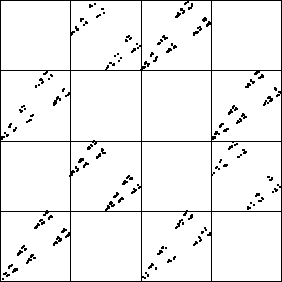
Recall the tent and logistic maps are among the simplest nonlinear mathematical systems.
Next, recall the coarse-graining
method of driving an IFS. The
| bin 1 | 0 <= x < 1/4 |
| bin 2 | 1/4 <= x < 1/2 |
| bin 3 | 1/2 <= x < 3/4 |
| bin 4 | 3/4 <= x <= 1 |
Here is the driven IFS - not random at all, lots of structure. Can we understand its pattern?.

|
First, we note some address length 2 subsquares appear empty. What are these addresses, and what are the bin-to-bin combinations that cannot occur?
| Empty addresses | Forbidden combinations |
| 12 | 2 -> 1 |
| 13 | 3 -> 1 |
| 22 | 2 -> 2 |
| 23 | 3 -> 2 |
| 32 | 2 -> 3 |
| 33 | 3 -> 3 |
| 41 | 1 -> 4 |
| 44 | 4 -> 4 |
Now suppose we drive the IFS randomly, except that none of the forbidden combinations is allowed. What do we get?
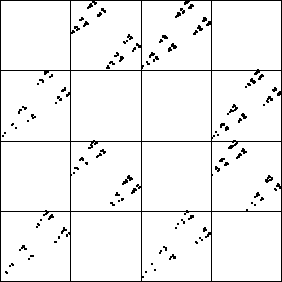
|
This looks like the original picture. In fact, it is.
Another way
to see this is to apply the deterministic IFS rules, but imposing the
forbidden combinations. Even though this logistic map is chaotic, at least
in terms of the driven IFS, it is very simple. Imposing eight forbidden
combinations completely determines the driven IFS.
In a moment we shall see what characteristic of the
First, here is the driven IFS for the
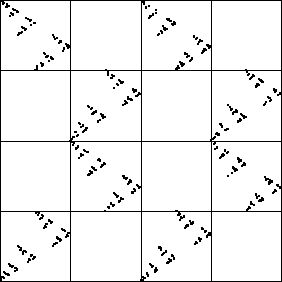
|
The empty addresses are 12, 13, 22, 23, 31, 34, 41, and 44. And again, imposing the corresponding restrictions generates the same picture. So this, too, is a simple chaotic process.
For another example, consider the
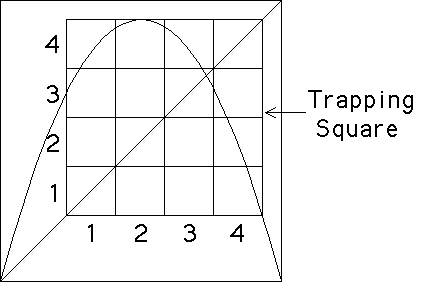
|
Note the trapping square: graphical iteration shows that points iterate into this square and subsequently never leave. That is, the eventual dynamics are constrained to lie in the trapping square. So we divide the trapping square into bins. What combinations are forbidden? We cannot go
| from bin1 into bin1 |
| from bin1 into bin2 |
| from bin2 into bin1 |
| from bin2 into bin2 |
| from bin2 into bin3 |
| from bin3 into bin1 |
| from bin3 into bin2 |
| from bin4 into bin4 |
Recall, this is the graph of the function, not the driven
IFS. So to find the forbidden combinations, we look above each bin on the
bottom of the trapping square and note which bins on the side of the
trapping square contain some part of the graph of the function. The left
picture is the IFS driven by the
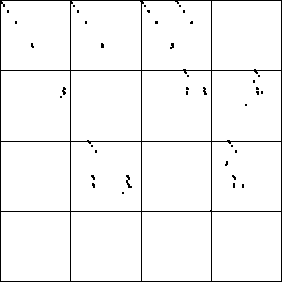
| 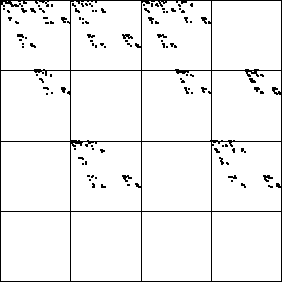
|
In examples such as the
Finally, suppose we consider systems more complicated than a
single logistic map. For example, take N logistic maps
and couple each to its nearest neighbors. Letting
| x1t+1 = (1-c)L(x1t) + (c/2)(L(xNt) + L(x2t)) |
| x2t+1 = (1-c)L(x2t) + (c/2)(L(x1t) + L(x3t)) |
| xt+13 = (1-c)L(xt3) + (c/2)(L(xt2) + L(xt4)) |
| ... |
| xN-1t+1 = (1-c)L(xN-1t) + (c/2)(L(xN-2t) + L(xNt)) |
| xNt+1 = (1-c)L(xNt) + (c/2)(L(xN-1t) + L(x1t)) |
Graphically, we have
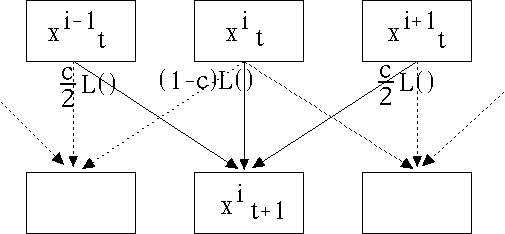
|
Here c is the coupling constant, a measure how how strongly
each value depends on its neighbors. For examaple,
In each generation we measure the average of the xit; that is, we measure
| zt = (x1t + ... + xNt)/N |
What happens if we drive an IFS with z1, z2, z3, ... ?
Let's start with a simple example:
| x1t+1 = (1-c)L(x1t) + cL(x2t) |
| x2t+1 = (1-c)L(x2t) + cL(x1t) |
Here we step through the driven IFS
for
Here are some pictures, taking
Return to Data-Driven IFS